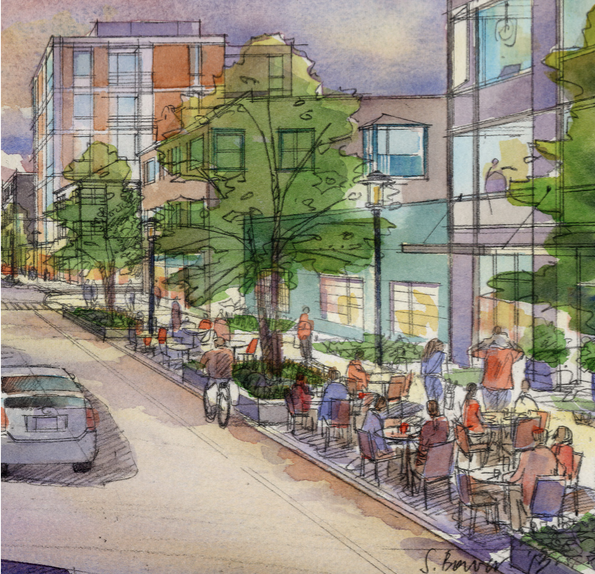The University District rezone and urban design legislation is headed to Council for review and deliberation later this fall. We covered the original draft proposal in three parts this past summer since there was so much meat to it. Seven key changes have been made since then, including:
- The setting of Mandatory Housing Affordability (MHA) requirements;
- Changes to floor area ratio allowances, including extra bonus floor area for developments that provide space for human services uses;
- Reducing the proposed area for the greatest allowed building heights;
- Expanding the applicability of historic preservation incentives;
- Eliminating some rezone proposals north of NE 50th St; and
- Extending proposed SM-U rezones on The Ave north of NE 45th St; and
- A handful of other zoning changes.
MHA Requirements
As we discussed on Tuesday, Mayor Ed Murray has released his proposal for specific MHA requirements that will apply to new development. The University District could be one of the first areas in the city to fully implement the requirements if approved. Generally, the required affordable housing set-aside would be in a band from 6% to 9% of residential units and 5% to 9% of total chargeable commercial space, or $11.00 to $20.00 per square foot, depending upon the zoning change and type of development.
For the high-rise SM-U zones, the per square foot cost would usually be $20 per square foot, or 9% of total residential units and 9% of the total chargeable commercial square footage across the board. This is different from the general MHA approach that usually has lower MHA requirements for commercial uses. The low-rise and mid-rise zones will be subject to the same MHA requirement bands that would apply to other Medium market rent areas of the city that have M1 development capacity increases. And the SM-U 85 zones on The Ave would have the lowest MHA requirements in the rezone proposal since capacity increases would only be modest changes over the existing NC3-65 zoning.
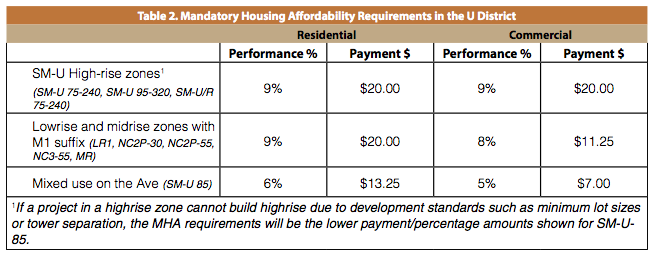
The MHA requirements will only apply to areas of the University District that are subject to the major rezone proposal (noted by the areas highlighted in the dark and medium blue tones below). Later next year, larger area-wide rezones could take place to the remaining unchanged zones highlighted by the light blue tone below.
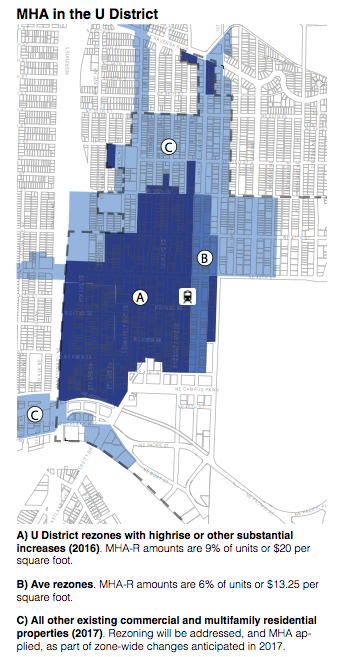
Changes To Floor Area Ratio Allowances
The updated proposal would make slight changes to the floor area ratio (FAR) allowances by adding a new incentive for human services uses and reducing the general maximum FAR for the SM/R-U 240 zones.
The proposal provides for a variety of FAR bonuses and incentives in SM-U zones, such as landmark structures, arts and cultural facilities, family-sized dwelling units, schools, and ground floor retail and services. Human services uses would be added as another option to obtain bonus FAR. Up to 0.5 FAR could be credited to other uses above the base FAR if a commensurate amount of human services floor area is provided in a new development. When seeking the FAR incentive, a developer would have to provide at least 2,500 square feet of human services space to qualify. The draft code outlines four other general requirements for the exemption:
- Human services spaces would have to be accessible for both the elderly and disabled;
- Wayfinding signage to the use(s) would have to be clearly visible from the street;
- The space(s) must be kept for human services uses for the life of the building; and
- Rent may not be charged for the use of the space.
If for whatever reason the human services space(s) cannot be leased up for human services uses after six months, provisions would allow the space to be converted for non-profit community uses or public space.
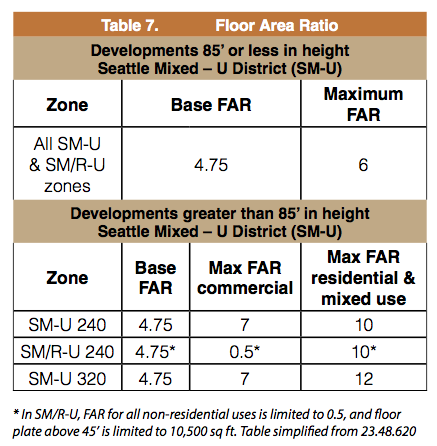
Additionally, the updated proposal would reduce the maximum FAR for residential and mixed uses in the SM-U/R 75-240 zone. The new proposed maximum would be 10.0 FAR, down from the 12.0 FAR originally proposed.
Proposed Zoning Map Changes
Since the summer draft proposal, six primary zoning changes are being proposed:
- Base maximum height changes. SM-U and SM-U/R zones, outside of the core high-rise area and along The Ave, would have a base maximum height of 75 feet. The base maximum height for SM-U zones on The Ave would be 85 feet and the core high-rise area would be 95 feet. For The Ave, this isn’t actually a change, but for all other SM-U zones it is, with the core high-rise area going up a floor in height and the other areas going down one.
- Contracting the core high-rise area. The area proposed for the most intense building heights would be smaller than originally proposed. Blocks south of NE 43rd St are no longer proposed to allow building heights up to 320 feet. Instead, these properties would be zoned as SM-U 75-240.
- Changes north of NE 50th St. MR zoning is no longer proposed north of NE 50th St. NC3-75 rezone proposals have also entirely been removed north of NE 50th St and replaced by a smaller number of NC3-55-M1 rezones. And properties that had been proposed to become NC2P-30-M1 on NE Ravenna Blvd have lost a floor in height from the NC2P-40 originally proposed.
- Extending SM-U zoning on The Ave. On The Ave between NE 45th St and NE 50th St, properties extending half a block deep from The Ave have been adeed to the proposal as SM-U 85.
- Contracting zoning changes on 15th Ave NE. A one-block stretch north of NE 47th St on 15th Ave NE was removed from the rezone proposal. The properties on that block had originally been proposed to go to SM-U 85. Another one-block stretch north of NE 45th St and on the east side of 15th Ave NE was also removed from the rezone proposal. The properties had originally been proposed to go to NC2-75.
- Nomenclature changes. The LR1, MR, and NC2P-55 areas essentially remain the same, but would now be designated as LR1-M1, MR-M1, and NC2P-55-M1 to match the new MHA nomenclature.
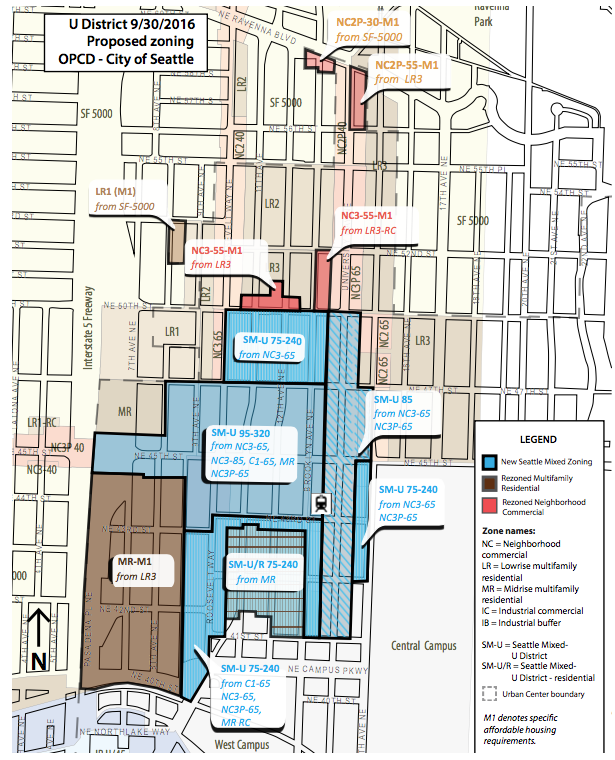
It’s worth reiterating that some of the rezones may come back outside of the University District rezone and urban design process. That’s because the City is committed to implementing area-wide MHA rezones to commercial and multi-family zones throughout the city next year–that would include portions of the University District.
Expanded Applicability Of Historic Preservation Incentives
With the proposed rezone adding SM-U zoning on The Ave, those areas would be able to qualify for the use of Transfer of Development Rights (TDRs) that originate within the neighborhood. Generally, the TDRs would come from properties that have designated landmark structures, but could also come from unreinforced masonry buildings. The purpose of this is to ensure that these structures are preserved and reinvested in. We previously wrote about how this would work:
OPCD is pursuing incentives to preserve designated historic landmark buildings and vulnerable masonry buildings. Known as “transfer of development right” (TDR), property owners of historic structures or vulnerable masonry buildings would be able to sell their development rights to other developers who want to build above the base zoning or floor area ratio in the University District (TDR is one of the incentive zoning options, as discussed above). Money derived from the sale of TDRs allows property owners with older buildings to reinvest capital into rehabilitation and restoration work. These older buildings typically embody some of the best aspects of the University District’s neighborhood character and rent at more affordable rates for commercial and residential space.
Essentially all properties zoned SM-U or NC3/NC3P may qualify as TDR sending sites (where development rights are being sent from) if there is an eligible vulnerable masonry building or designated landmark structure located on the site. Properties in the SM-U zone may also send development rights from certain types of open spaces. The amount of TDR floor area that can be sent from a particular site is limited to the amount of floor area from an existing eligible structure or open space and up to a total maximum of the base FAR that the site is entitled to. TDRs sent from NC3/NC3P and SM-U sites may only be used on eligible receiving sites zoned as SM-U within the University District. Since the TDR program is specifically designed for the neighborhood, all TDRs created there stay there; they can’t be transferred outstide of the community.
An alternative carrot for historic preservation is FAR bonuses and exemptions. On sites zoned SM-U with a designated landmark structure, developers could receive an FAR bonus of up to 0.5 FAR over the base zoning if they retain the landmark structure and rehabilitate it and exclude the historic structure floor area from the maximum FAR calculations. The 0.5 FAR bonus is the maximum permitted, but the actual bonus would be based upon the square footage of the historic structure. So if the square footage of the landmark would only equate to 0.3 FAR of the site, then that is the maximum FAR bonus that the development could attain. However, projects that seek the FAR bonus cannot double dip with TDR. If a project goes the FAR bonus route, then the developer would have to forego TDR for sending and receiving.
What’s Next
The proposal will go to the the City Council’s Planning, Land Use, and Zoning (PLUZ) Committee next month. On November 16th, a public hearing (6.15pm) on the legislation will be held at Hotel Deca in the University District. Preceding the public hearing will be an open house (5.30pm) and presentation (6pm) on the proposal. The PLUZ Committee will also carry out further review and deliberation on the proposal at additional meetings toward the end of the year.
U District Urban Design – Final Recommendations 10-17-16 by The Urbanist on Scribd
Stephen is a professional urban planner in Puget Sound with a passion for sustainable, livable, and diverse cities. He is especially interested in how policies, regulations, and programs can promote positive outcomes for communities. With stints in great cities like Bellingham and Cork, Stephen currently lives in Seattle. He primarily covers land use and transportation issues and has been with The Urbanist since 2014.

